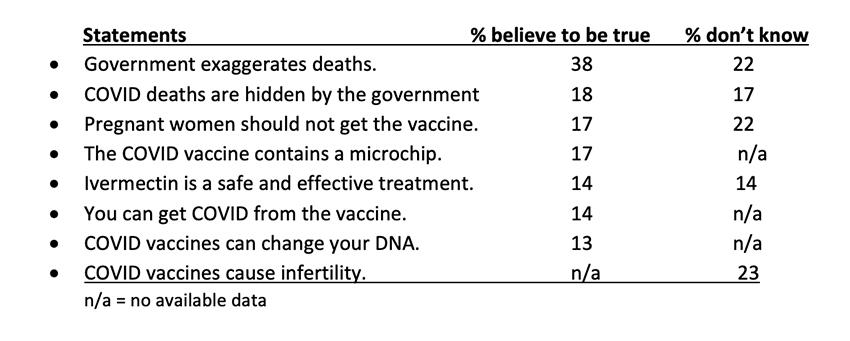78% have heard at least one of these myths and say that it’s either true or they are not sure.
 Rest assured, we are confident that none of them is true, except Ivermectin, for which we too are unsure.
Rest assured, we are confident that none of them is true, except Ivermectin, for which we too are unsure.
There is an important difference between this survey and our previous analyses of vaccinations based on state or county averages. The KFF survey results are based on individual data, i.e., counts. Our work assumed that a statewide average reflects individuals. For example, combining the average percentage of Republicans with the average rate of vaccinations would reflect the percentage of individual Republicans who were vaccinated - this is unlikely to be the case.
The KFF survey’s demographics were similar to that of the nation: 60% White, 16% Hispanic, 12% Black; 35% urban, 49% suburban, 16% rural; equal shares with household incomes < $40,000, from $40,000 to $90,000, and above $90,000. Unvaccinated adults tended to be younger and more likely Republican than fully vaccinated adults.
Who?
The survey stratified data by vaccination status and by pandemic responses.
- 55% of vaccinated adults identified as Democrats, while only 15% identified as Republicans.
- Vaccination status did not differ by race or income, but vaccinated adults tended to be more highly educated.
- Democrats were more likely to believe in vaccines and wear a mask indoors at work.
- Fewer Blacks tended to feel safe from COVID outside the home, as did those with lower household incomes, but both groups were more likely to wear masks when working indoors.
- Prevalence of booster shots did not vary by race, but Democrats were twice as likely to have been boosted than Republicans, and the elderly were about three times as likely as adults aged 18-29.

Trends in the KFF national vaccination data have leveled off. Continued progress in “full” (the first two shots) has been supplanted by the push for first and second boosters. The alarming feature here is the absence of a trend in the “never vaccinators” that comprised 17% of adults, notwithstanding the recent suggestion of an increase. The CDC has restricted complete vaccination to those receiving boosters; the first two jabs are a prerequisite. As a result, the 17% who resist the first shots can never be boosted, at least by definition, leaving us with a maximum vaccination coverage of about 83% of the U.S. population.

The top three responses are discomforting in terms of ever reaching a national consensus. However, they should be viewed in the context of our responses to other public health concerns, such as smoking or the use of seat belts. [2] Consider these risky behaviors:
- 14% of the population smokes.
- 14% don’t wear seatbelts.
- 17% refuse COVID vaccines.
- 18% think that childhood vaccines should not be mandatory.
- 19% don’t believe that obesity is harmful.
- 21% are exposed to second-hand smoke.
- 24% binge drink.
- 65% of the total population has not had booster shots.
About 52% of the U.S. adult population receives a flu shot each year, resulting in an estimated 6300 lives saved (and 51 lost from the vaccine itself). By contrast, since its introduction in January 2021, an estimated 300,000 lives have been saved by COVID-19 vaccinations. Each COVID shot has saved about 13 times as many lives as each flu shot.
The most crucial difference here is that, while COVID vaccination will surely reduce your risk, it may also help save the lives of strangers you have never met.
[1] https://www.kff.org/coronavirus-covid-19/dashboard/kff-covid-19-vaccine-monitor-dashboard/#boosters
[2] These statistics were obtained from a variety of online sources.


